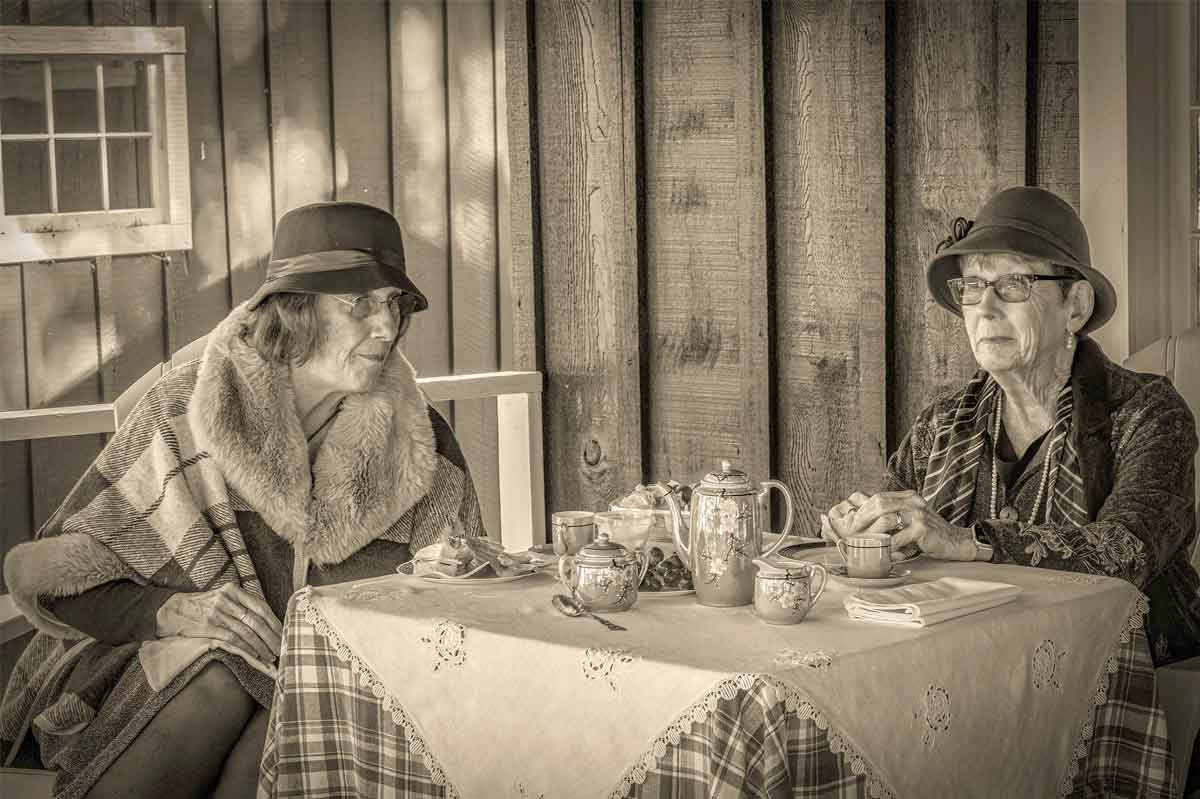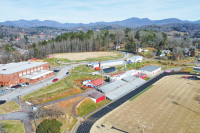Word from the Smokies: Inaugural event shows that Elkmont is not a ghost town
 Volunteers from the Elkmont Roving Corps — a group of dedicated volunteers who help protect and interpret the Elkmont Historic District of Great Smoky Mountains National Park — adopted one of the Daisy Town cabins and chose a theme for the inaugural Daisy Town Day on November 4, 2022. These ladies dressed in 1920s attire and hosted a tea party. Paul Driessche, Great Smoky Mountains Association photo
Volunteers from the Elkmont Roving Corps — a group of dedicated volunteers who help protect and interpret the Elkmont Historic District of Great Smoky Mountains National Park — adopted one of the Daisy Town cabins and chose a theme for the inaugural Daisy Town Day on November 4, 2022. These ladies dressed in 1920s attire and hosted a tea party. Paul Driessche, Great Smoky Mountains Association photo
If you’ve been to the Elkmont Historic District of Great Smoky Mountains National Park, you’ve probably come across a gathering of vacant buildings — many with wide porches, stone chimneys and wooden shutters.
Some of the buildings are slowly returning to nature, their leftover stonework an enduring declaration that they were once here. But many others are being restored, namely those in a neighborhood called Daisy Town.
Old empty buildings tucked unexpectedly in the mountains playing tug-of-war with encroaching mosses and fallen leaves may strike visitors as a little spooky at first. Brad Free, interpretive park ranger with GSMNP, emphasizes, however, that Daisy Town is not a ghost town — and the park’s first annual Daisy Town Day this past November sought to show visitors exactly why that’s true.
When Free was stationed on the Cherokee, North Carolina, side of the park, he worked with elders of the Eastern Band of Cherokee Indians in the Museum of the Cherokee Indian.
“Every day when I’d leave, they’d always say, ‘See you later,’” he said. “One day I asked them, ‘Do you ever say goodbye?’ They told me there was no word in the Cherokee language that means goodbye because they believe that if you say goodbye, it means they’ll never see you again. If they say, ‘see you later,’ then you’ll meet again either in person or in spirit.”
Curious, Free later asked one of his EBCI colleagues if the Cherokee believe in ghosts. “He said, ‘No, as long as we tell stories, we believe that things don’t die.’ And I believe that what we do in the National Park Service is tell stories. As long as we tell stories about the people who lived here, then we don’t have ghost towns here. So, that’s what our volunteers are doing at Elkmont — telling the stories that keep that place alive.”
Related Items

- When leases on the Daisy Town cabins terminated at the end of 1992, Eleanor Dickinson (née Creekmore), whose grandfather built one of the cabins, lobbied to get the Elkmont district placed on the National Historic Registry in 1994. Photo by Paul Driessche, Great Smoky Mountains Association.

- Members of the Elkmont Roving Corps — a group of dedicated volunteers who help protect and interpret the Elkmont Historic District of Great Smoky Mountains National Park — dressed up in clothing from between 1910 and 1934 and conducted fun, educational activities at the inaugural Daisy Town Day on November 4, 2022. Photo by Paul Driessche, Great Smoky Mountains Association.

- With dedicated volunteers, lively storytelling, and hands-on experiences, Daisy Town Day cemented the Elkmont Historic District in the history books as a spirited place of old tales that can be woven into our modern-day love of the Smokies. Photo by Paul Driessche, Great Smoky Mountains Association.
The Great Smoky Mountains National Park saw around 14 million visits in 2021. The park’s vast biodiversity, rich history and ample recreation has come to mean adventure, joy and memories for so many people since its founding. Yet, its status as a popular tourism destination started well before the park became a park. In fact, one could argue that it began in the early 1900s when the Little River Railroad Company built a line between Elkmont and Townsend, Tennessee.
The goal of this railroad was to transport logs from Little River Lumber Company’s operations in the Smoky Mountains to the sawmill in town. When the railroad extended into Knoxville, however, Elkmont quickly became a go-to destination for Knoxville families looking to escape the city’s summer heat and smog. Daisy Town was one of these respites, a collection of summer vacation homes for members of the Appalachian Club.
“We’ve never really talked about the tourism history of the Smokies,” Free said. “We have good programming around the Cherokee, early settlers, logging industry, Civilian Conservation Corps and early history of the park, but that tourism history that really built this area is so important too.”
As part of the effort to share that tourism history, the park held the inaugural Daisy Town Day on Nov. 4, 2022, from 10 a.m. to 2 p.m. in the Elkmont Historic District. Members of the Elkmont Roving Corps — a group of dedicated volunteers who help protect and interpret the Elkmont Historic District — dressed up in clothing from between 1910 and 1934 and conducted fun, educational activities. Each volunteer adopted one of the Daisy Town cabins and chose a theme for their stop along the event. Men sat on the cabin porches playing cards, ladies dressed in 1920s attire hosted a tea party and other volunteers talked about past beekeepers, how children played and went to school there, the history of the churches and cemeteries in the area and the logging industry.
Dan Paulin is passionate about telling Elkmont’s stories. Author of “Lost Elkmont,” he remembers first seeing the little neighborhood in the 1980s, when several leases in Daisy Town were still active.
“I was just amazed, as was my wife, that this existed,” he said. “I remember turning to her and saying, ‘Hey, honey, we’ve got to rent one of these! This is so cool.’ Little did I know at the time that it was a private community.”
But now, as a founding member of the Elkmont Roving Corps, Paulin gets to spend time there sharing the resource with people from near and far. He’s grateful for Eleanor Dickinson (née Creekmore) whose grandfather built one of the Daisy Town cabins. When leases on the cabins terminated at the end of 1992, she lobbied to get the Elkmont district placed on the National Historic Registry in 1994.
“Without her, there could have been no Elkmont Daisy Town Day and no cabins for visitors to GSMNP to enjoy,” said Paulin.
Because of that protection and the park’s work to preserve the area, he gets to see the value in his interactions with park visitors each week — including the more than 700 who came to Daisy Town Day.
“Some park visitors I encounter have even stayed in some of the cabins or are descendants of former leaseholders,” he said. “It’s really a hoot when you get to meet someone who has that history with one of the cabins. They’re so appreciative of what we’re doing.”

- In the early 1900s when the Little River Railroad extended into Knoxville, Elkmont quickly became a go-to destination for Knoxville families looking to escape the city’s summer heat and smog. Daisy Town was one of these respites, a collection of summer vacation homes for members of the Appalachian Club. Photo by Paul Driessche, Great Smoky Mountains Association.

- More than 700 park visitors came to the inaugural Daisy Town Day on November 4, 2022, in the Elkmont Historic District of Great Smoky Mountains National Park. Photo by Paul Driessche, Great Smoky Mountains Association.
With dedicated volunteers, lively storytelling and hands-on experiences, Daisy Town Day cemented the Elkmont Historic District into the history books not as a ghost town, but rather as a spirited place of old tales that weave into our modern-day love of the Smokies, interest in our collective ancestry and will to keep our memories alive.
“I have to brag on the volunteers,” Free said. “The passion they have for preserving this area and educating visitors on it is really special. Their enthusiasm and how much work and thought they put into this event was truly humbling to me. Their hearts were really in it and the event could not have been done without them.”
Keep an eye out for announcements from GSMNP in the fall about the event’s next chapter and how you can help listen to and share Daisy Town’s stories as part of the park’s living history of Smoky Mountain tourism.
Korrin Bishop is a freelance writer and editor with publications in U.S. News & World Report, Southern Living, Fodor’s Travel, Sierra and Smokies Life, the primary benefit for members of Great Smoky Mountains Association, which provides this column. Bishop was a 2020 writer-in-residence at Sundress Academy for the Arts in Knoxville and is a certified Tennessee naturalist. To learn more about her work, visit korrinbishop.com.









